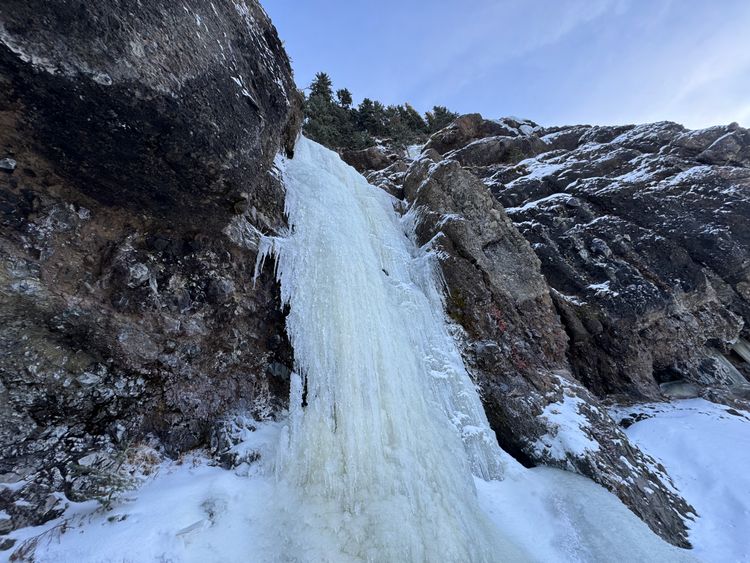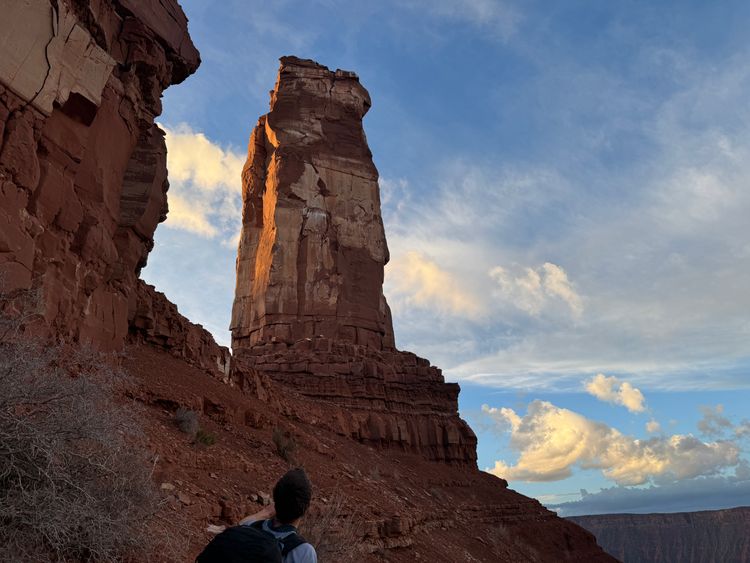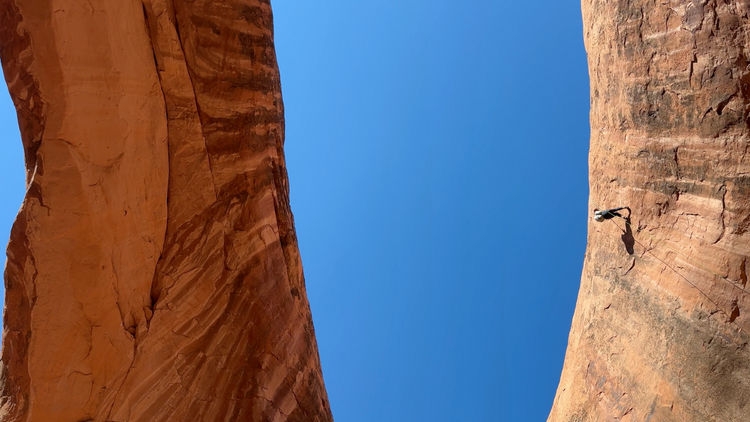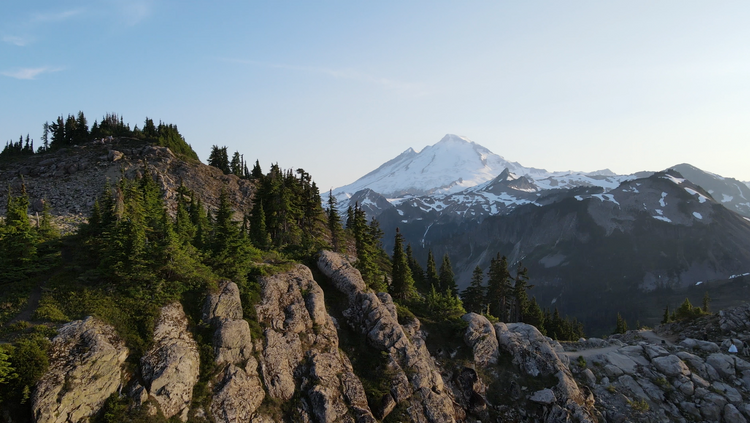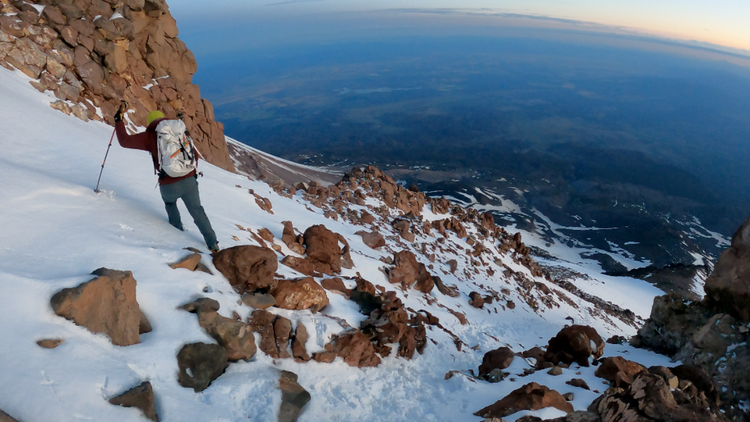Notes from the Copper City
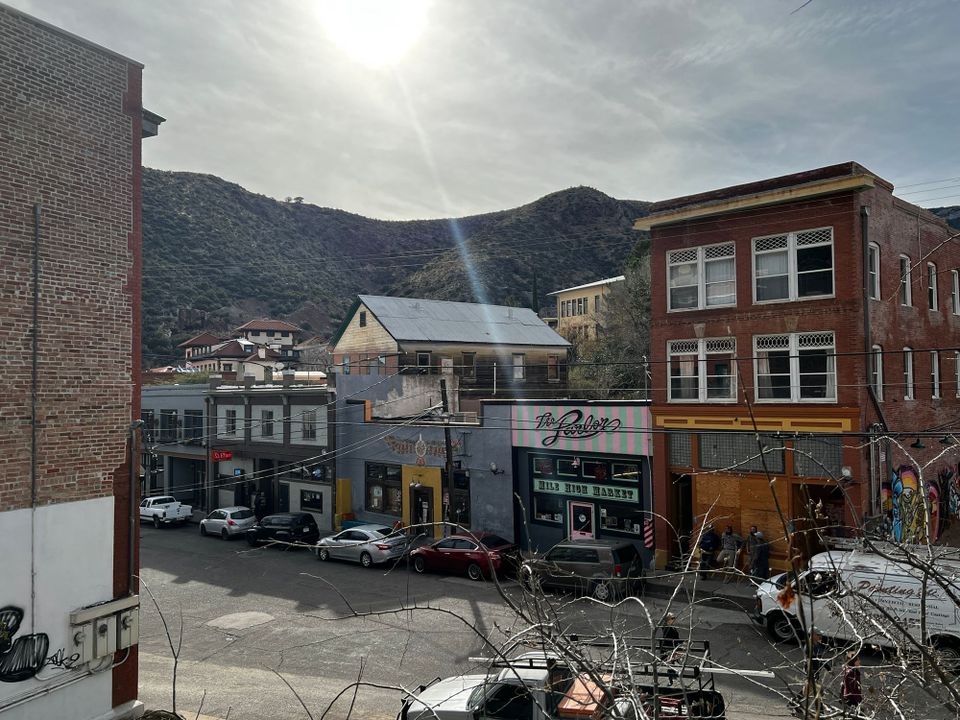
"We don't throw food in the trash because javelinas will rip the bags apart," Fiona explains as we navigate her parent's kitchen. We're visiting her family in Bisbee, Arizona for Christmas. It's a beautiful and classic southwestern town nestled in the Mule Mountains, which are full of desert creatures. The first night of our stay, we toss scraps of Spam out the front door and wait. Not even five minutes go by when we begin to hear snuffling and a low growl in the bushes. A gigantic boar-like animal emerges from the scrub and starts vacuuming up the bits of pink meat. Its eyesight is bad enough that it can't see us watching it ten feet away. "That," Fiona gestures at the rumbling, Spam-devouring beast "is a javelina. They get into everyone's garbage and they're known to kill dogs."
Bisbee sits about 12 miles north of Naco, Mexico. The Copper City, as it's dubbed, sprang up around 1880 because of the mining concerns that found copper, gold, and silver in these hills. At one time, Bisbee grew faster than San Francisco, and at its peak held around 20,000 people. Phelps Dodge, the company who owns the majority of the claims around the city, quit mining copper in 1975. The town's numbers dwindled in the final decades of the mine's operations. When Fiona's dad, Mike, showed up, balls of tumbleweed ambled down the vacant streets.
Mike and Joanne (Fiona's mom) were part of an influx of artists, hippies, and adventurers into Bisbee right after the miners and their families cleared out. Fiona's parents are originally from Ypsilanti, Michigan, but, after moving to town, found themselves in the midst of a wild and wide-ranging crowd from Haight-Ashbury and other far flung places across the nation. The eclectic horde of twenty/thirty somethings came for the semi-lawless environment and the abandoned miner's shacks which made for cheap real-estate or good places to squat. Betsy, Mike's sister, bought the lot and house for Mike for $300 in 1973.
Betsy herself is involved in a love affair with the ghost of George Sellers, a local painter and sculpter who died in 1964 and previously resided in her house. She never met him while he was alive, but "she said she feels his presence every night before she goes to sleep, tugging on the bed covers." She wrote an account of it called Sellers in the Kitchen: Romancing the Ghost of George Wiley Sellers.
A couple days before Christmas, Mike and I walk into the Cochise County courthouse, a beautiful Art Deco with an adobe kind of flare that some call "Pueblo Deco." A lady outside recommends we go in and see the map. The map, which is a plaster three-dimensional representation of Cochise County, sits halfway up the stairs. Turns out George Sellers made it.
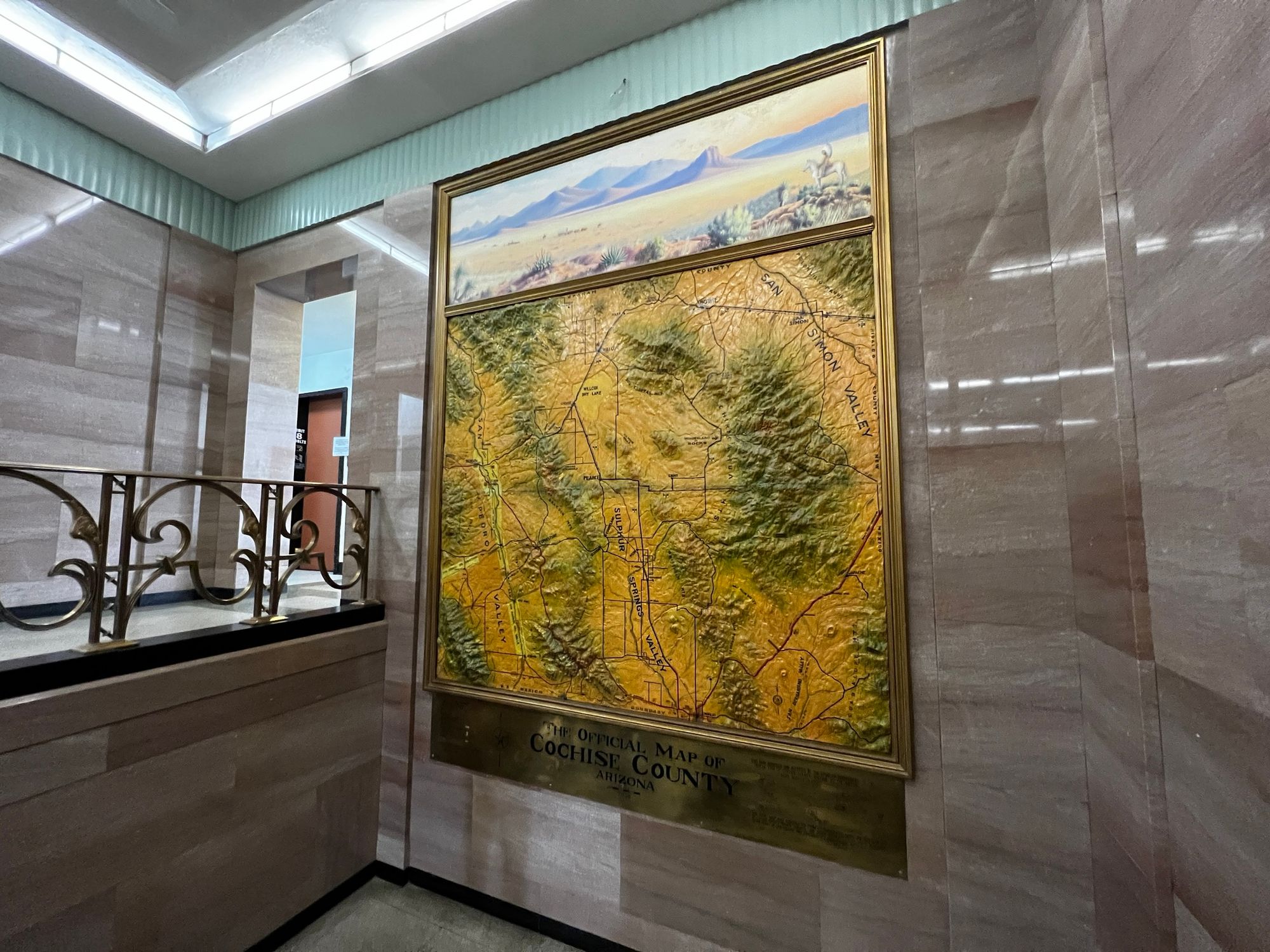
The next day, Mike shows me around town and our first stop is the Buddhist shrine: a cave adorned with Tibetan prayer flags, pictures of the Dalai Lama and other trinkets. He tells me that Art, a man in his early eighties who lives nearby, built it. Apparently, Art has also willed his land to a local Buddhist monastery after he passes. The steps up to the hill to the shrine are painted in bright orange colors, like some kind of path of enlightenment one might find in the Himalayas.
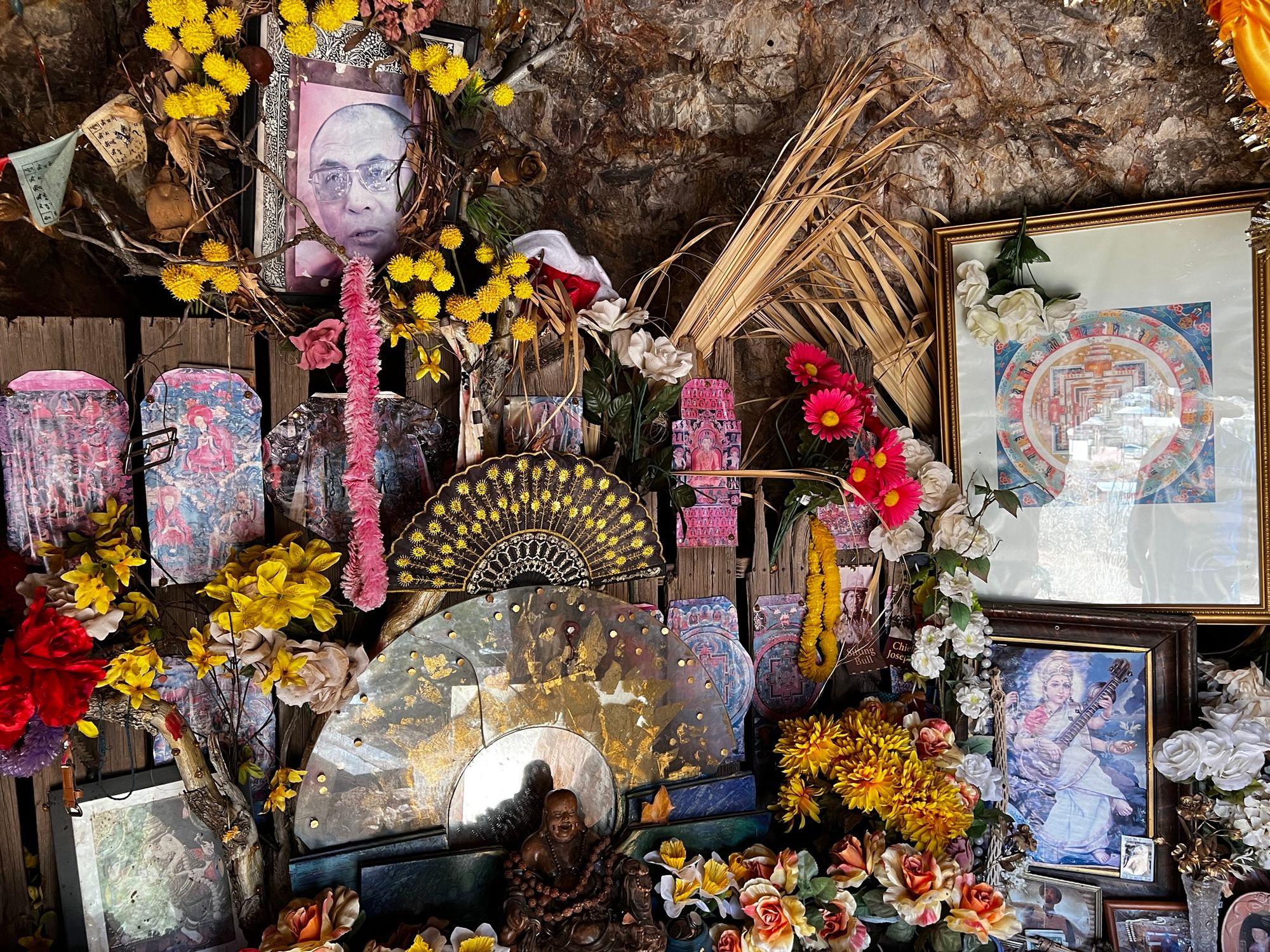
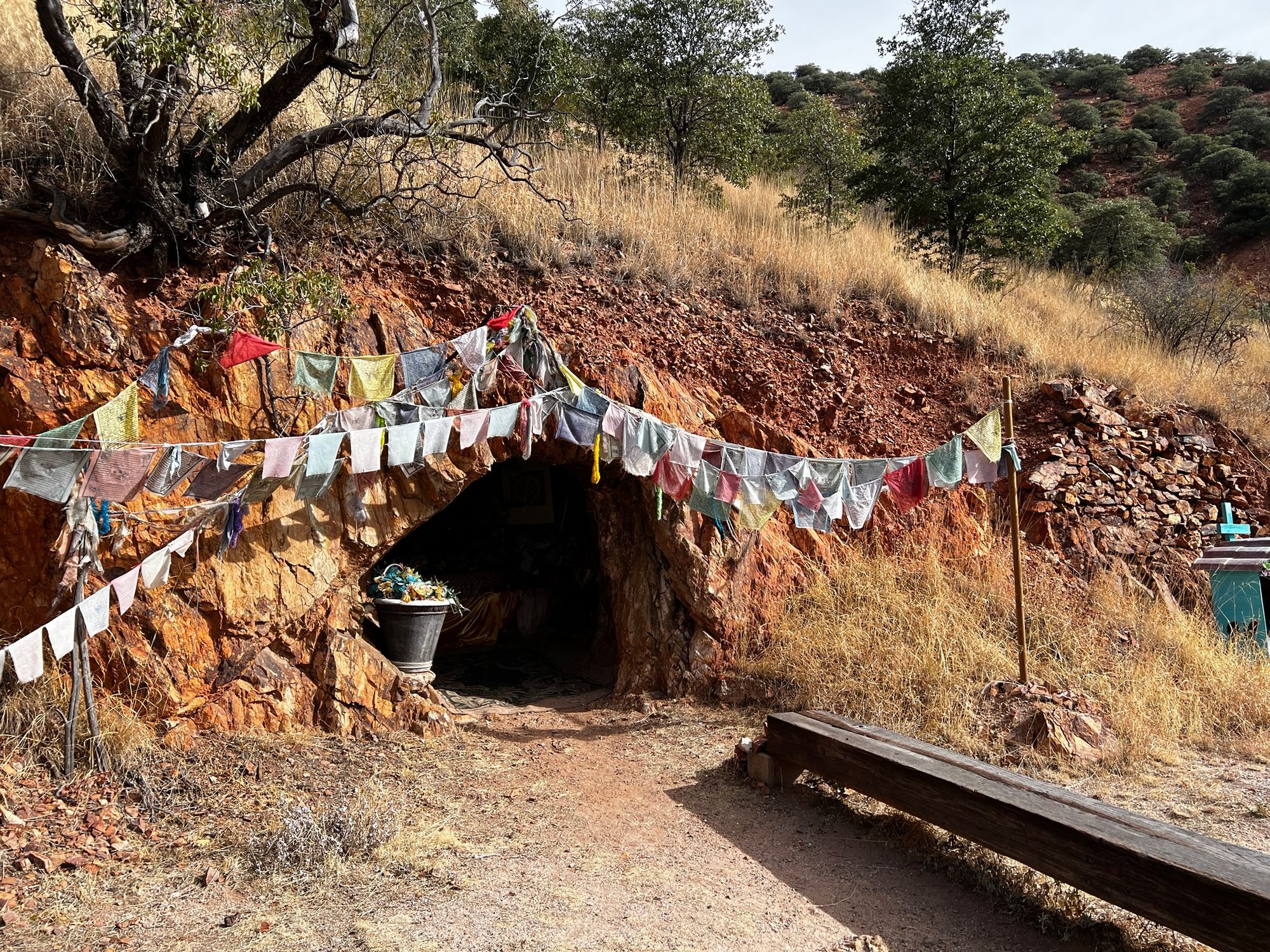
Art also maintains the Bisbee Cross Shrine, which is up on the hill behind Mike and Joanne's house. Later, Fiona, Mike and I trek to the top. Various people over the years built it up, Mike tells us. They poured immense amounts of concrete over the rock to form shelving and small grottos for various devotions. Many of the small caves in the wall are occupied by the Virgin of Guadalupe and memorials to passed relatives or pets from folks all over town. We even find a mural of Che Guevara, of whom Art is a big fan.
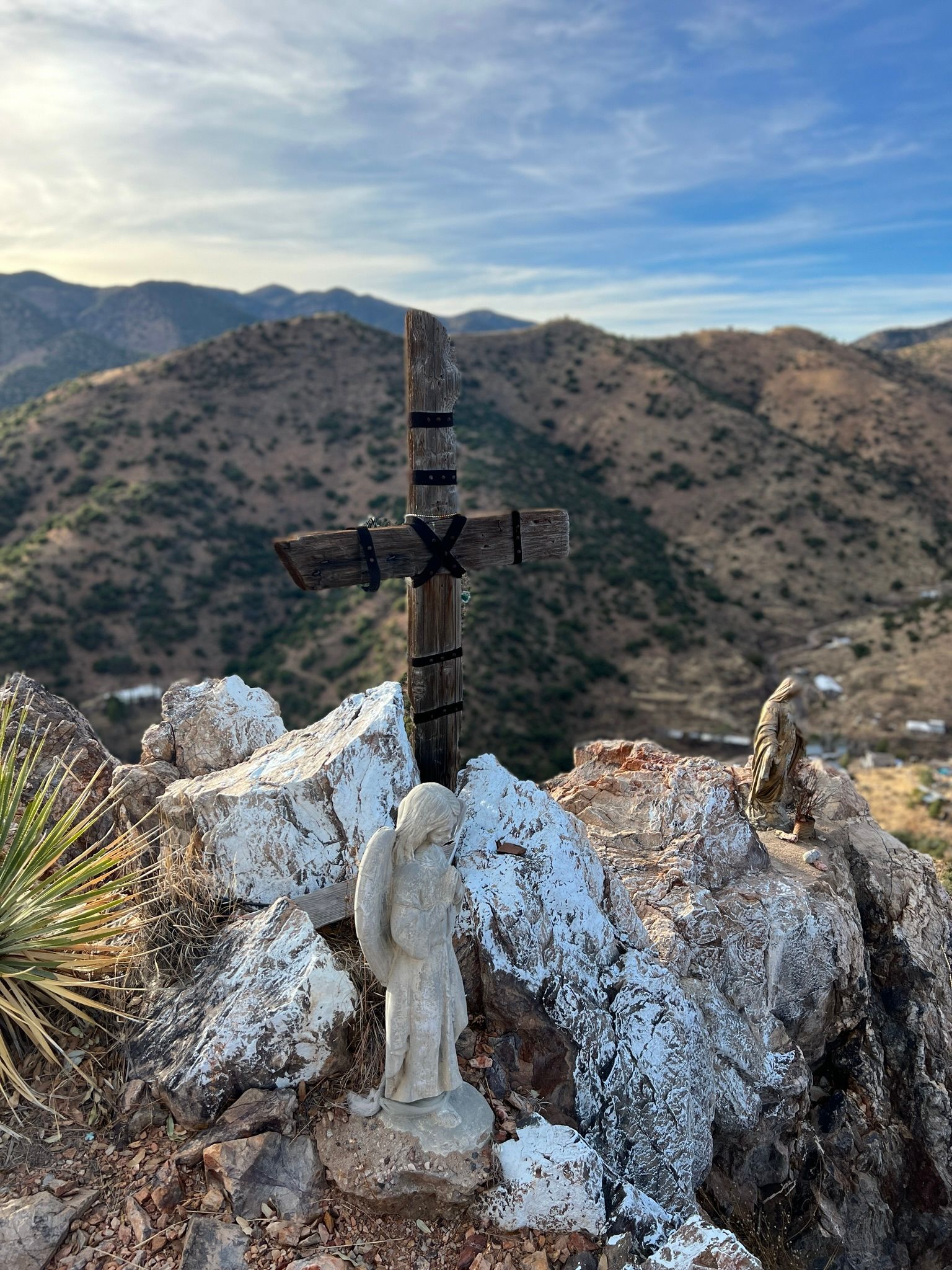
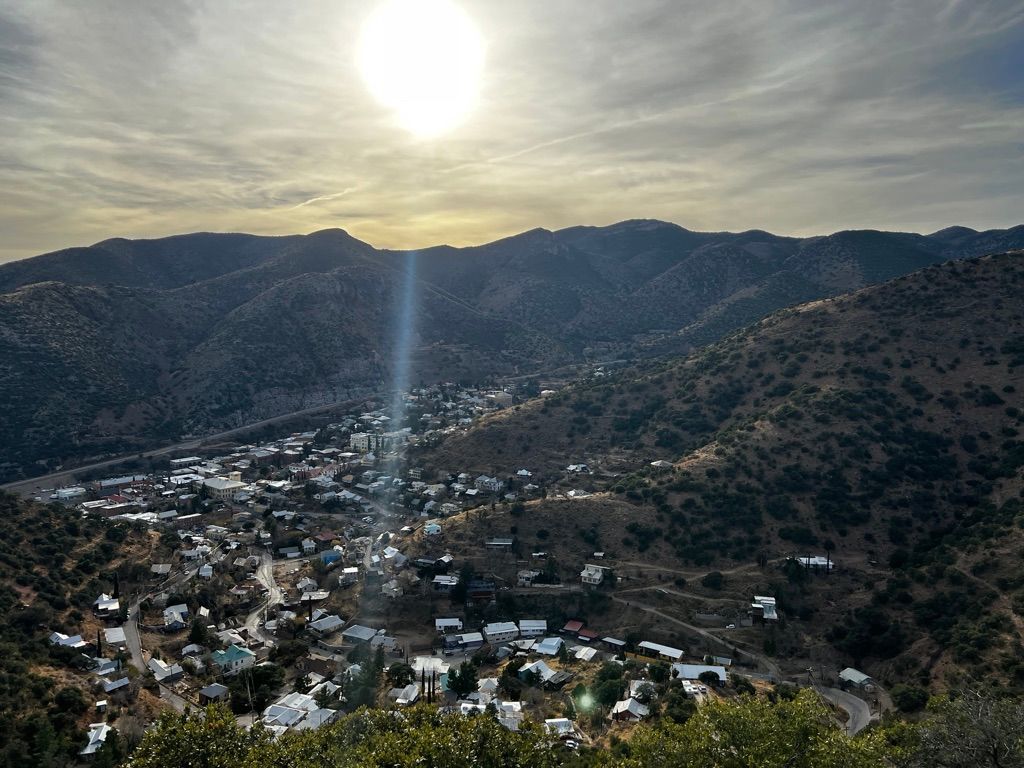
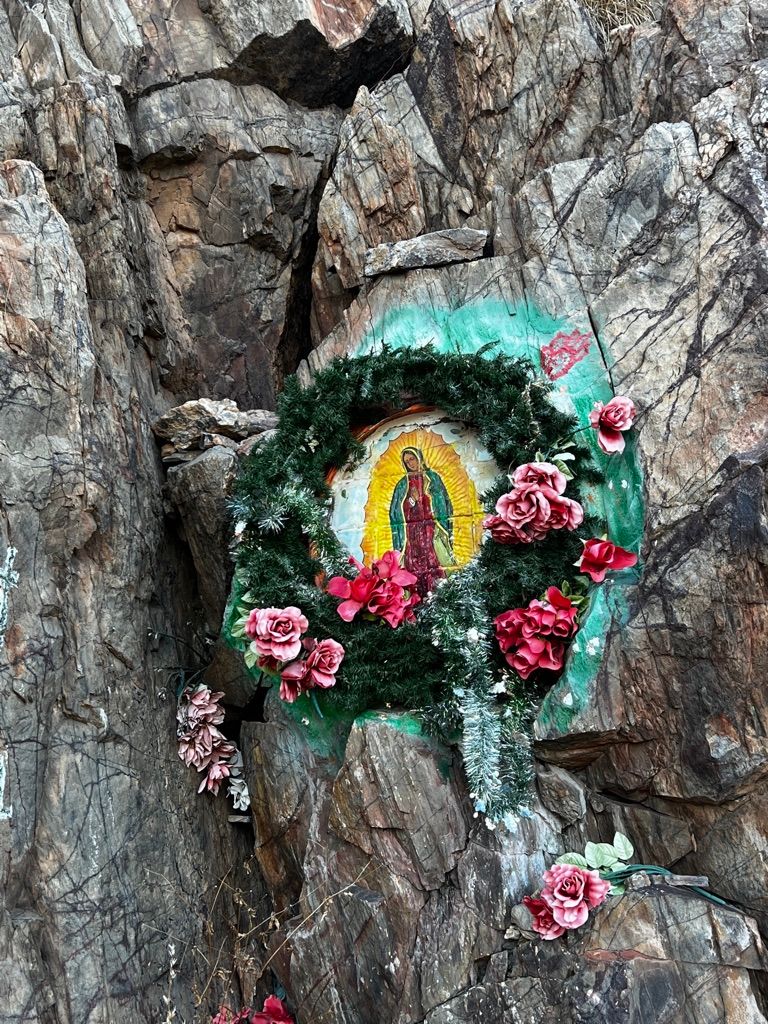
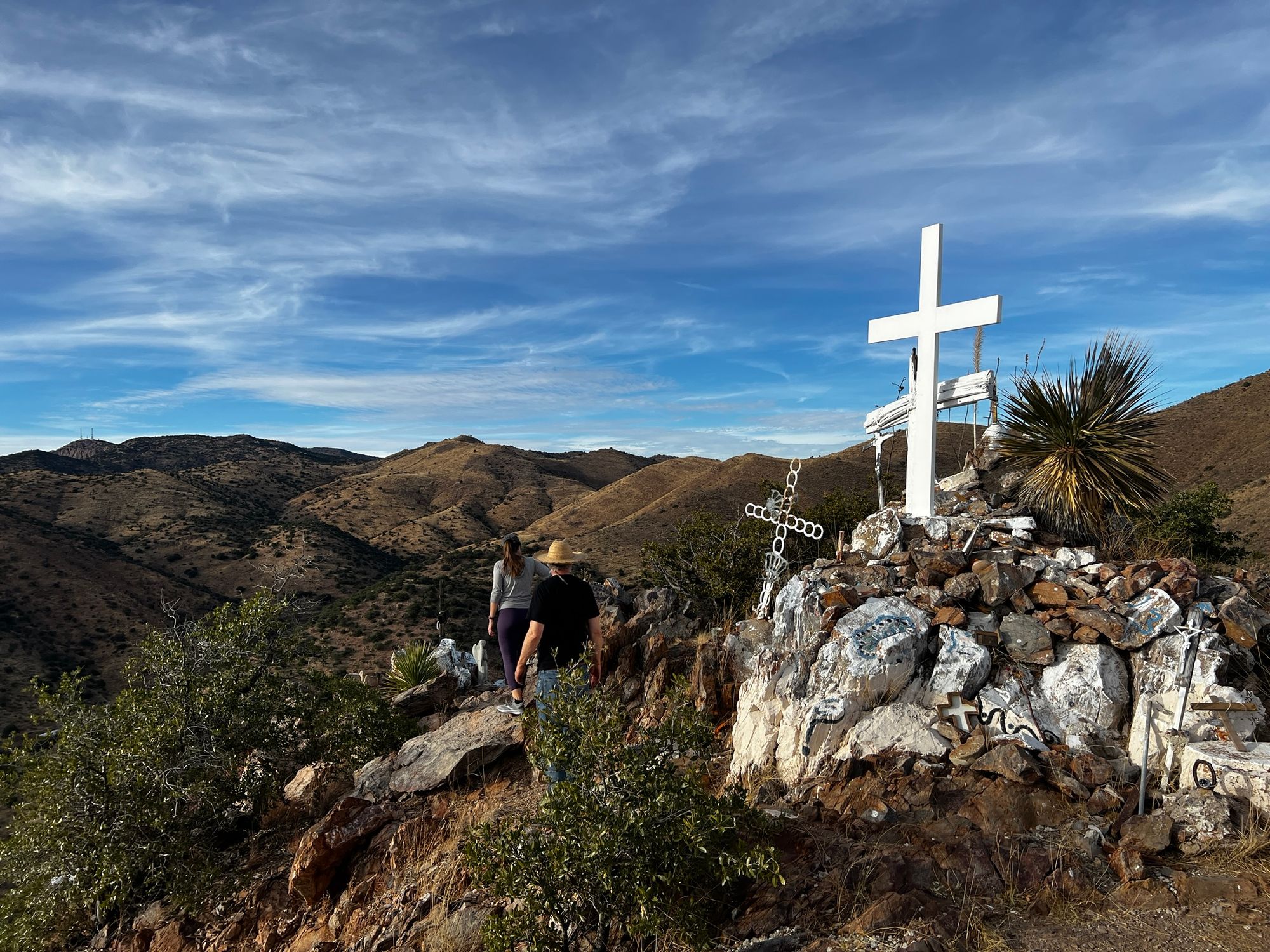
As we survey the canyon that clutches Bisbee with all its corrugated-metal-roofed buildings, Mike fills us in on more characters in town.
"Down there," he points at what looks like a garbage dump at the very top of the town, "was where Coyote used to live. Funny guy. He's passed away now, but he tried to recruit Joanne and I into his cult one time." He says this matter-of-factly.
"How?" Fiona and I ask.
"Well he turned up at the house with a bag of weed to welcome us into town--this was right after we moved here--and we invited him inside. We drank a bunch of beer and he smoked nearly all of the marijuana and then told us that he and his family guided people through psychedelic journeys. Y'know 'shrooms and LSD and stuff. It was a kind of commune with a bunch of people living there in the garbage."
"Was it also some kind of weird sex thing like a lot of cults?" I ask.
"Not that I know of. But, anyhow, he invited us to his place to do mushrooms and join his little community and we just never went."
Mike tells us that some years later the fire department got called because of a blaze in the junkyard in the middle of all of the dwellings in Coyote's commune, and he came out with a rifle and warded them off.
We wend our way down from Art's mountaintop shrine and we hunt for a cave where Jerry "Buckets" Barta used to live. Buckets, as he was known around town, was a drifter. He got his name because he would carry buckets of plant seeds across Bisbee and pop them into the ground where he thought they needed to go. Buckets was also a thief.
"He was a pleasant enough guy to have over, but he'd leave and you'd realize that things were missing. Like your peanut butter, or other snacks. But he'd also return the favor in his own way...leaving gloves or other small items on our doorstep, " Mike says to us as we search the landscape. "One time, we had dinner at the house and he invited me back to his cave for a drink. We clambered up the hill and went in his cave, which is loaded with things, books and food. After hanging out for a little while inside, he made a pass at me and I said no. Then he got mad. As he bellowed at me for refusing him, the mule near Coyote's house started braying, which you can hear well across the canyon. Buckets screamed how even the mule heeded him and that I should too. I got out of there real quick."
We never find the cave. Mike thinks it's back further up the trail from where we looked and none of us are feeling especially like searching more after our hike. I ask what happened to Buckets and if he was still around. Mike says that, one day decades ago, the guy just drifted on and was never seen again.
We head back to the house. Fiona's parent's home sits at the top of a very long staircase that's been there for probably a hundred years. Mid-way up the stairs, we stop momentarily to look at the abandoned house on the left.
"Our neighbor, who was not a kind man, used to live here until a few years ago, when he shot himself," Mike says regretfully. "It was a bad scene. He must have been in there for some time because the TV, which was one of those old ones, shorted out after being on for so long and got stuck on this red color. So, when they finally discovered the body, he was bathed in this satanic red light in his bedroom. Apparently he was a gun collector too, and the police carted loads of weapons out afterward."
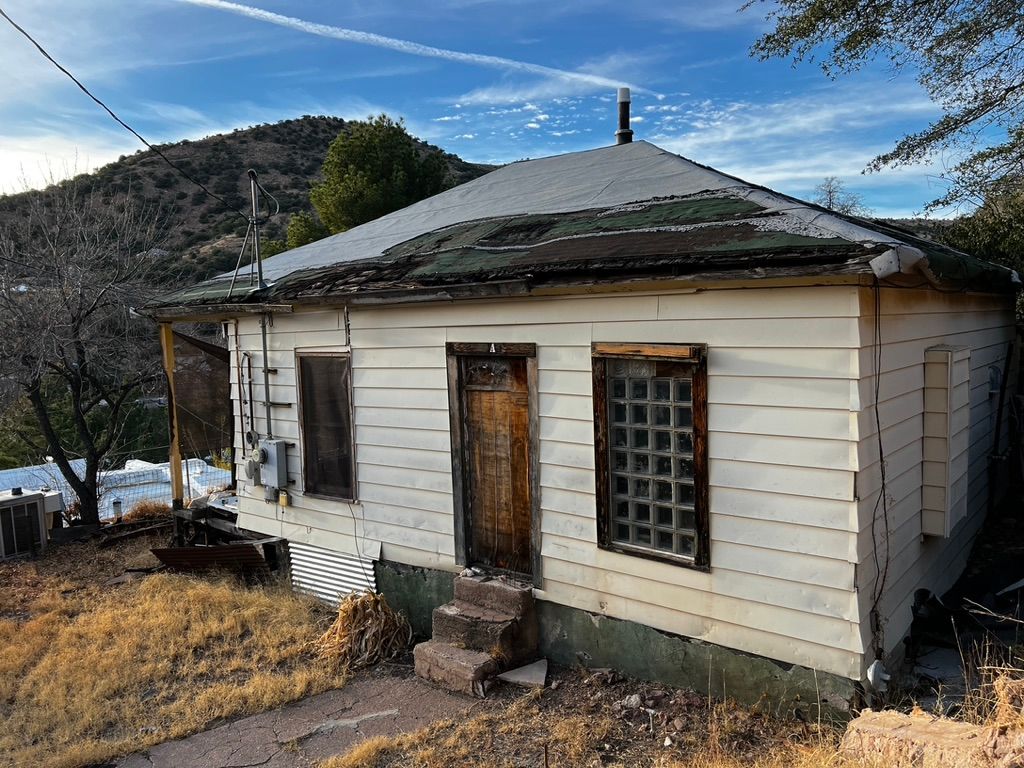
We ascend the rest of the stairs to the house where Mike makes us an ad-libbed cocktail of Saguaro syrup and tequila. The syrup, which he watched a Native American woman concoct from the cactus in a pot in the desert, looks and tastes much like molasses. Though it's a deep brown and sort of viscous, the mixture is quite good. The sweetness blunts the edge of the Jose Cuervo.
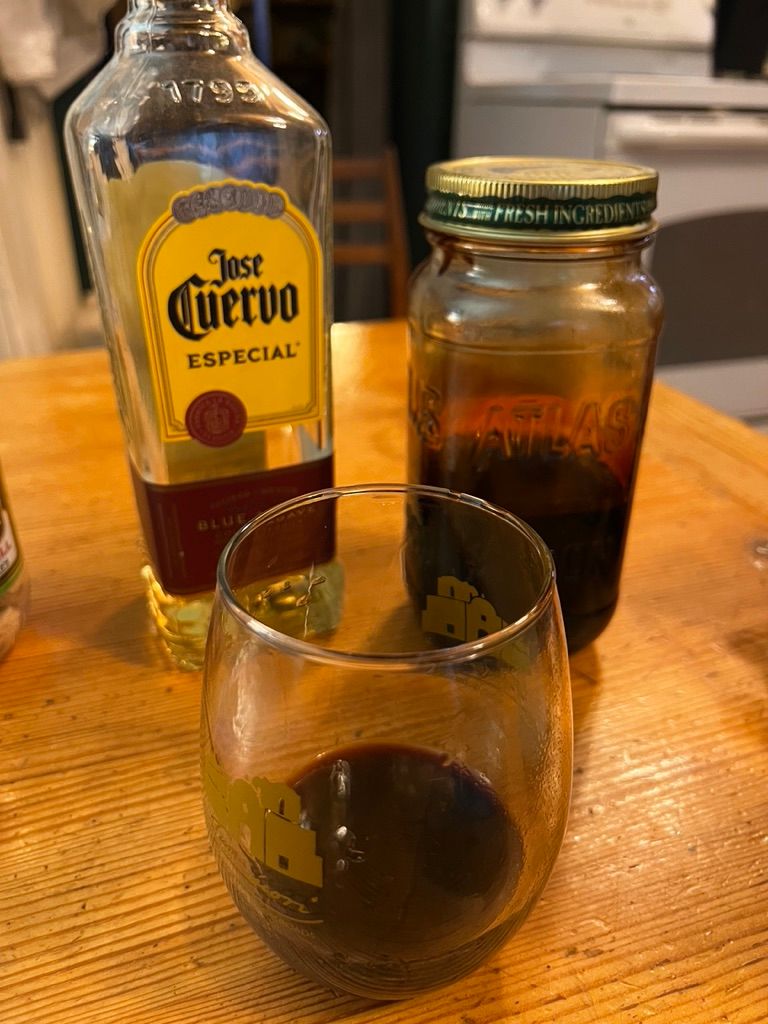
The night of Christmas Eve, we tour the city to see the lights. We stop into the Copper Queen Hotel (built in 1902) and the girl at the front desk, who has a tattooed face, beckons us inside to have a look around and see the architecture. It's gorgeously appointed. I really have the impression that "they don't build 'em like this anymore." It's absolutely haunted I am assured. The hallways sure seem like it. They're dimly-lit and extend to a vanishing point like something out of The Shining. The carpet is worn and stained. The door knob slides out of its socket when we try to go out on the balcony.
The hotel claims that every room has a story. There's a framed sign-in sheet next to one with John Wayne's scrawled signature on it. Other notable guests according to their site: "Lee Marvin, Lee Remick, Michelle Pfieffer, Julia Roberts, Kiefer Sutherland, Ollie North, First Lady Nancy Reagan, Jake Lamotta, Gabriel Giffords, John McCain, and family members of Linda Ronstadt."


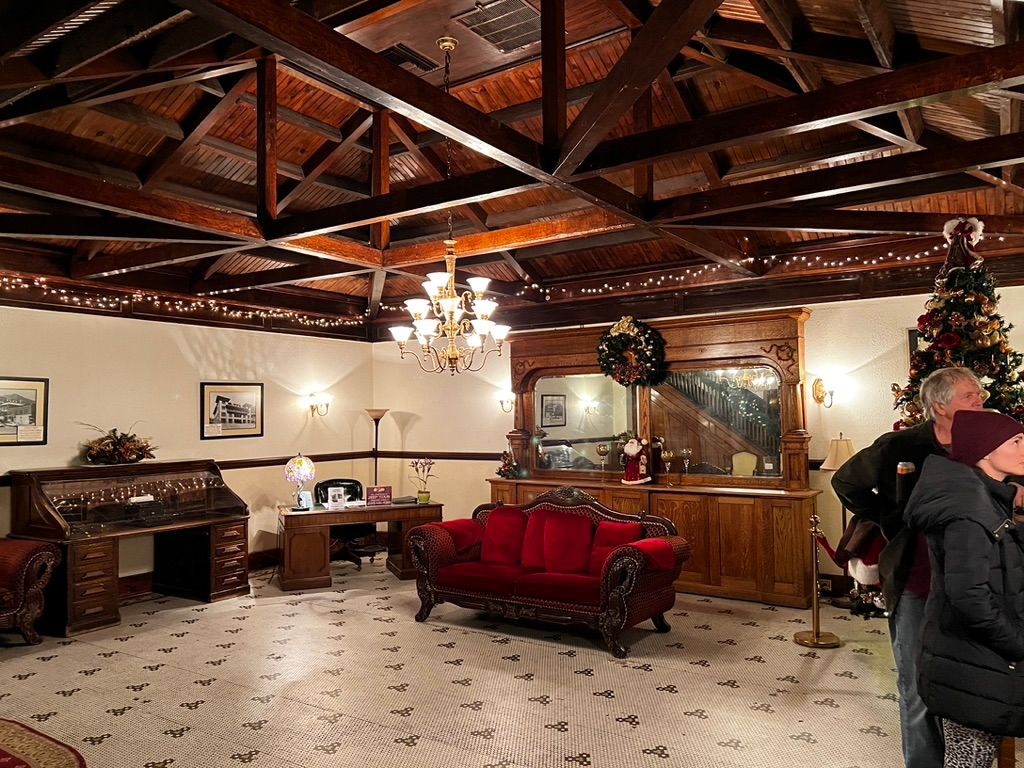
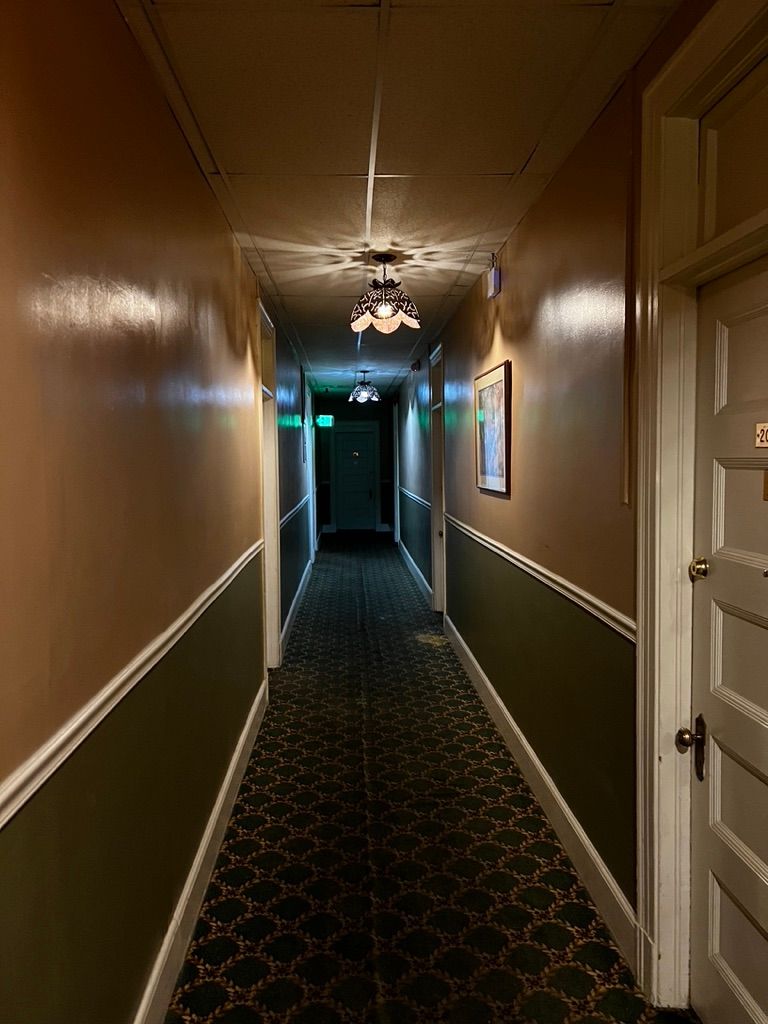
We exit the hotel and proceed to the main drag, which is adorned with charming lights zig-zagging the road. All of the shop windows are illuminated and full of unconventional stuff. Our stroll is very pleasant and quiet until we come up on the The Bisbee Grand, which has live music going. I think they're playing a cover of American Girl by Tom Petty. There's a homeless guy outside walking back and forth and belting along with the band's voices, but adding syncopated rap lyrics in between the verses. As we get closer, we see the singing-rapping guy yelling obscenities and harassing some other passersby, so we cross the street and he doesn't notice us.
The Jonquin Motel has a phone booth outside with a big, circular sign on top that reads "Poems." It alternates fluorescent colors. Upon inspection, we see that the phone inside lets you dial a specific set of numbers for poetry readings. A placard inside provides a legend for which number gets you which poem. Betsy, Fiona's aunt, has various poems listed next to the numbers and we try a few out. Unfortunately, none of them seemed to connect. We get a bit bummed out by this.
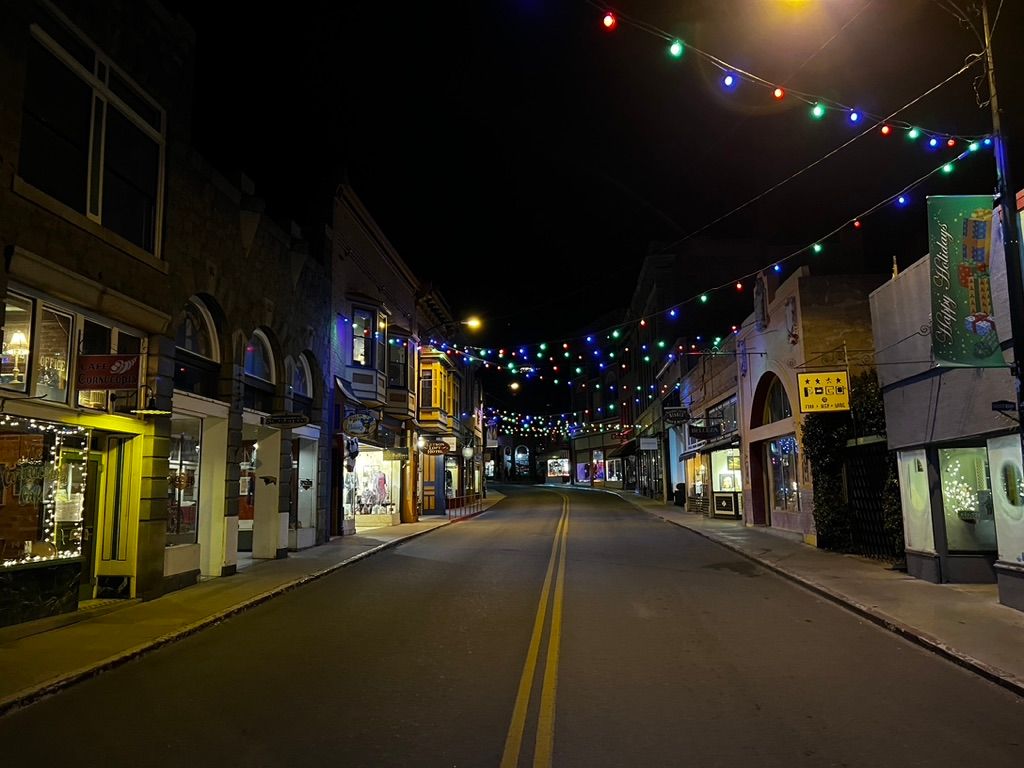
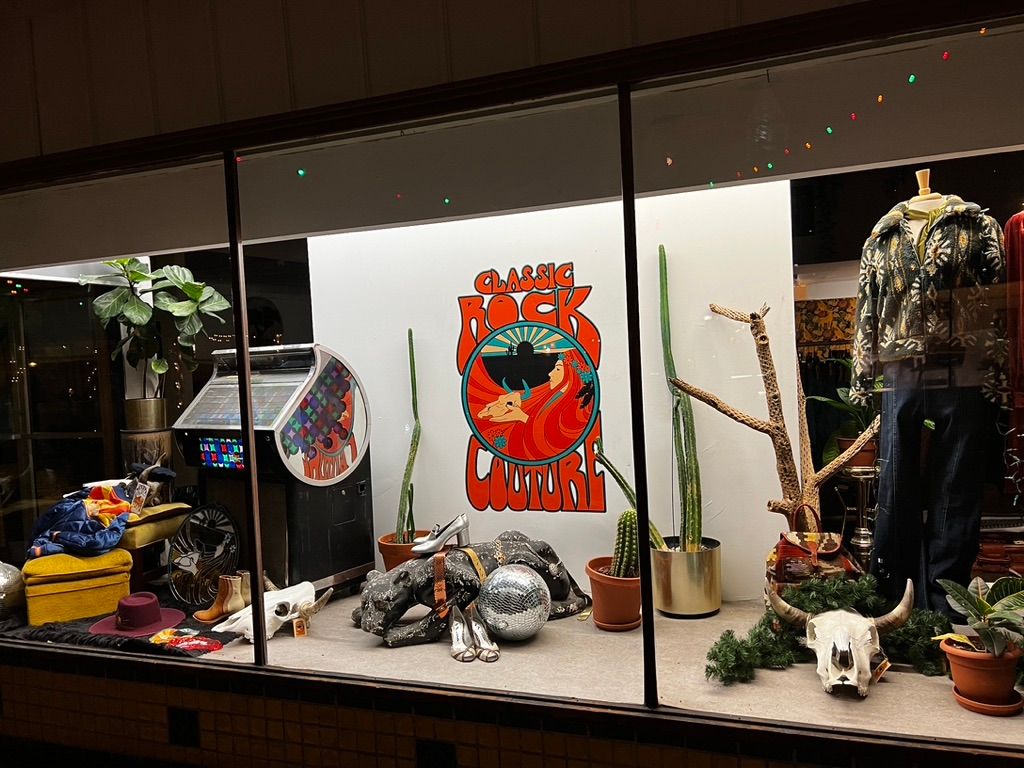
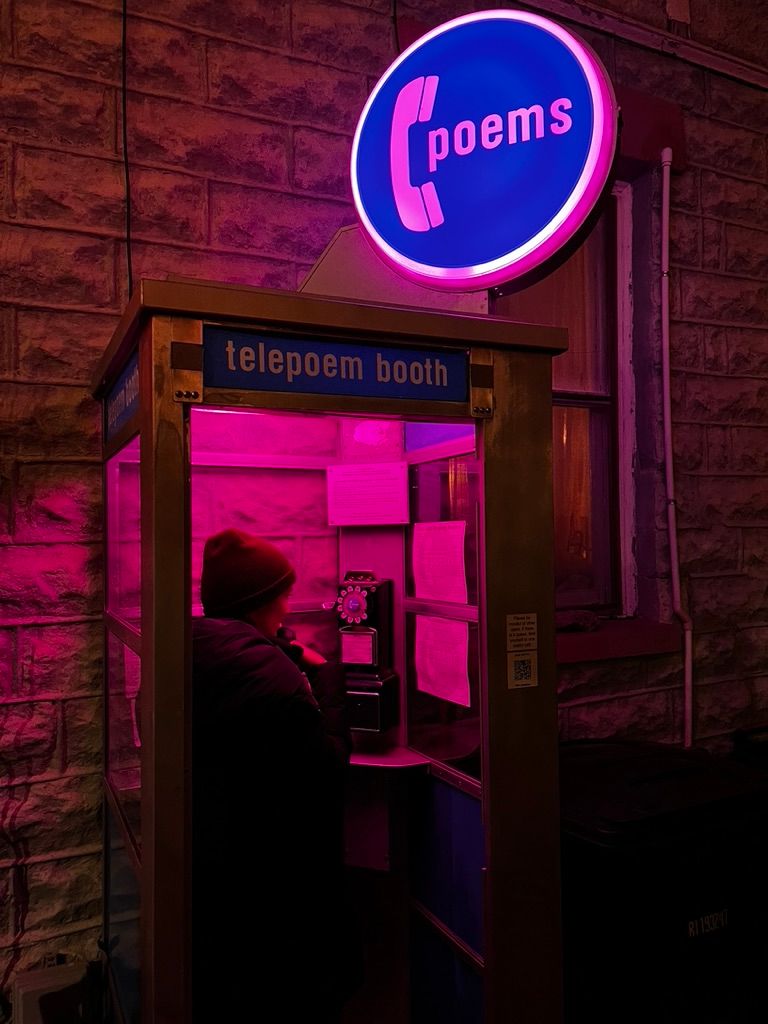
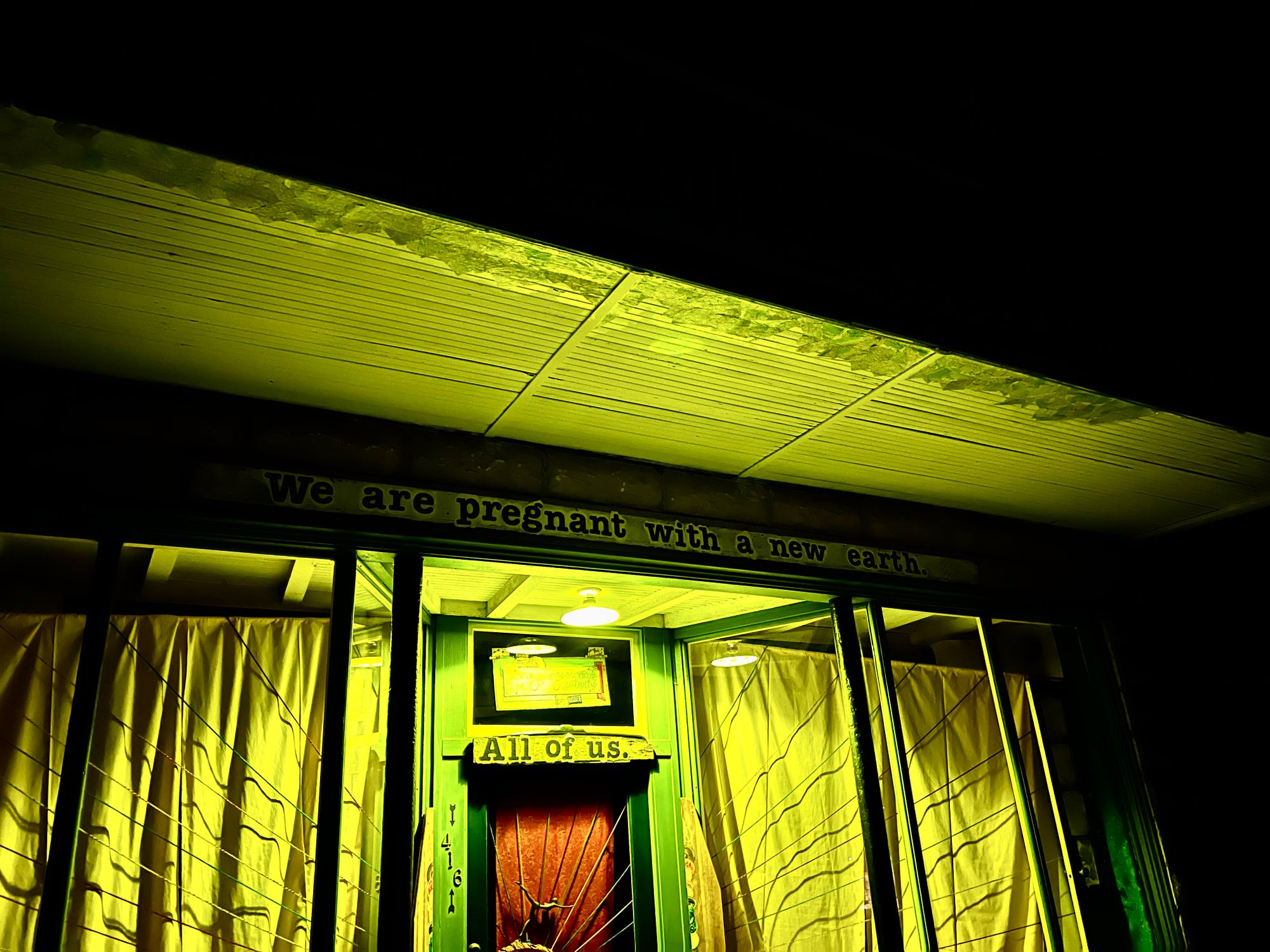
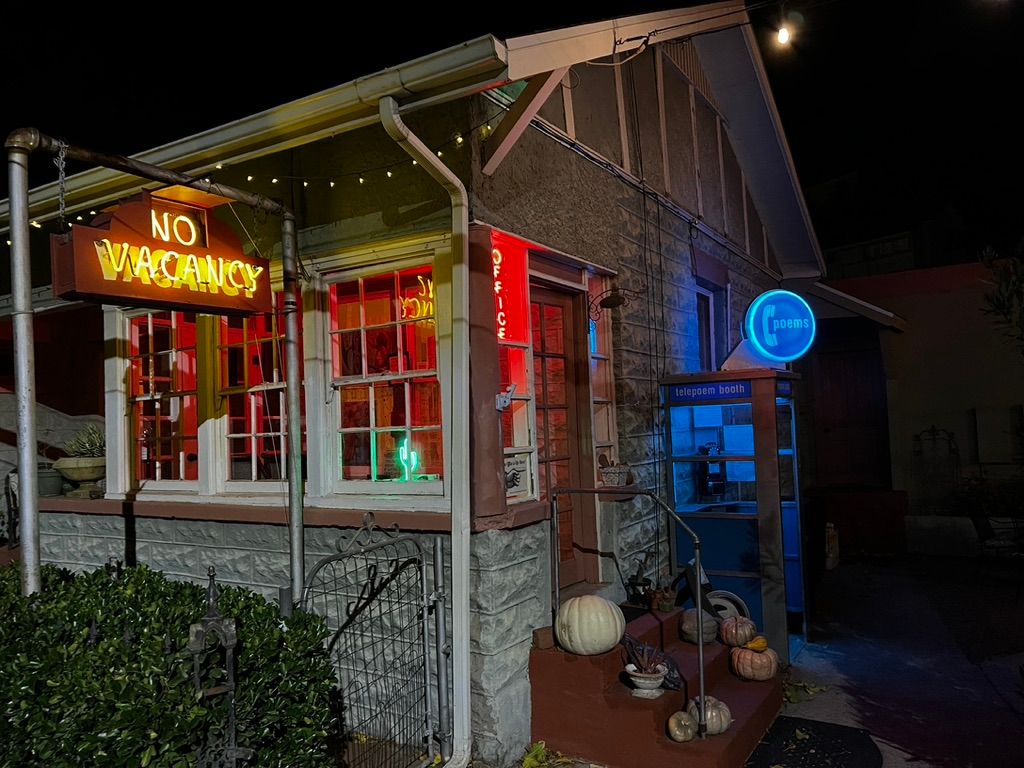
Christmas morning in Bisbee is lovely. Mike and Joanne go out before Fiona and I wake up and light a fire in one of the two hangout sites they've built in their backyard which extends far up the red-rock mountain. We join them at their spot and start a big cookout, complete with percolated coffee, bacon, charbroiled spam (which I would not recommend), and french toast from the cast iron. It's delicious and cozy. While listening to carols, we feed peanuts to the birds, who swoop down from their perches on giant agaves and other desert vegetation.
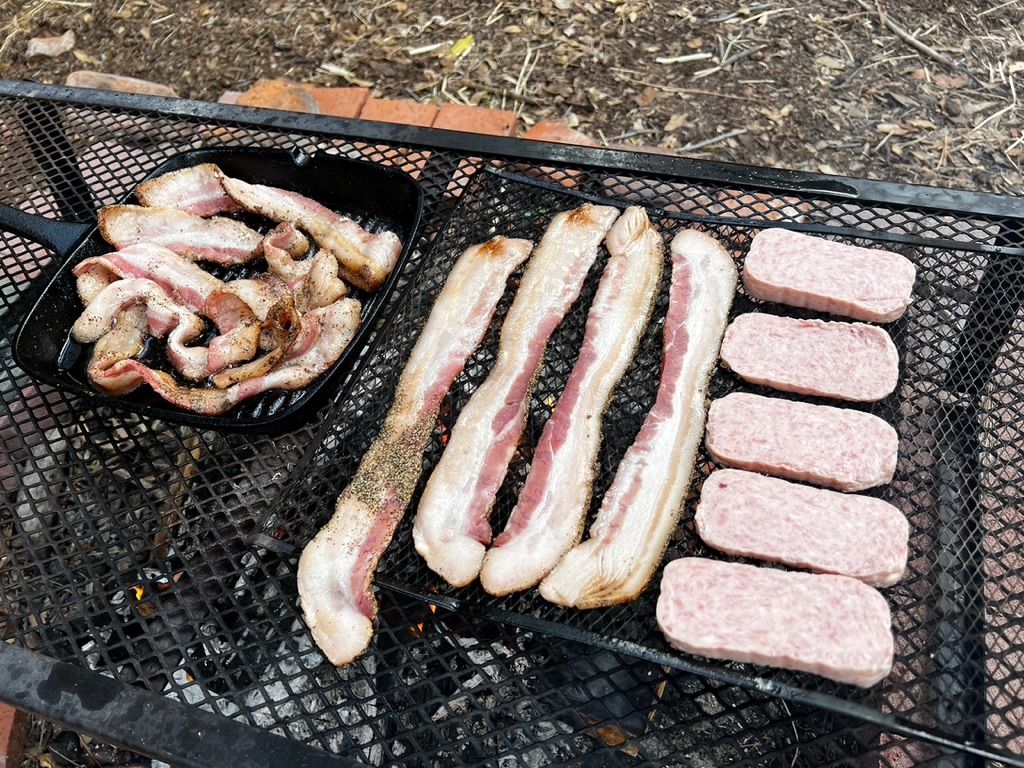
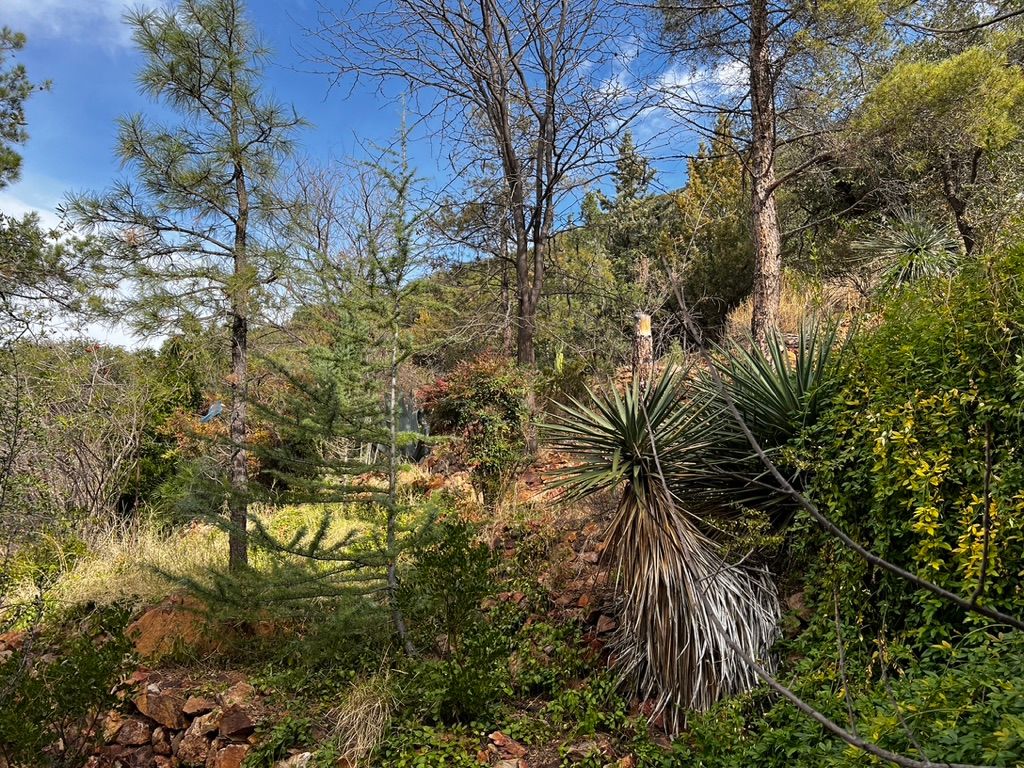
As we sit by the fire sipping coffee after our feast, I ask Mike who lives in the purple-painted house next door. The family that lives there now has only been there a few months. Retirees from another part of the state. But Mike says that when he first came to Bisbee "it was occupied by a father and mother, whose names escape me, and two sons. There was Harry and then José."
Turns out that Harry was gay and dating a US soldier from Fort Huachuca on the down-low. José ran drugs over the border and the father, a minister in a one-room church in Star Canyon, was married to a sex worker he brought from Mexico. Harry invited Mike over one day to take Polaroids of him dressed in a bra in front of a giant American flag, which Mike did, presumably for Harry's boyfriend. But at some point, Harry got kicked out of the house and so Mike let him and his boyfriend live in the backroom of what is now Fiona's childhood home for a while. Around that same time, Mike says, a man named Grey Wolf, a wanderer who collected herbs across the American west and sold them in local markets in western towns, also stayed at the house. Grey Wolf always carried a rifle and shot game to survive. In one event, Mike was walking home and found Grey Wolf cooking a porcupine over a fire on a bend on Youngblood road.
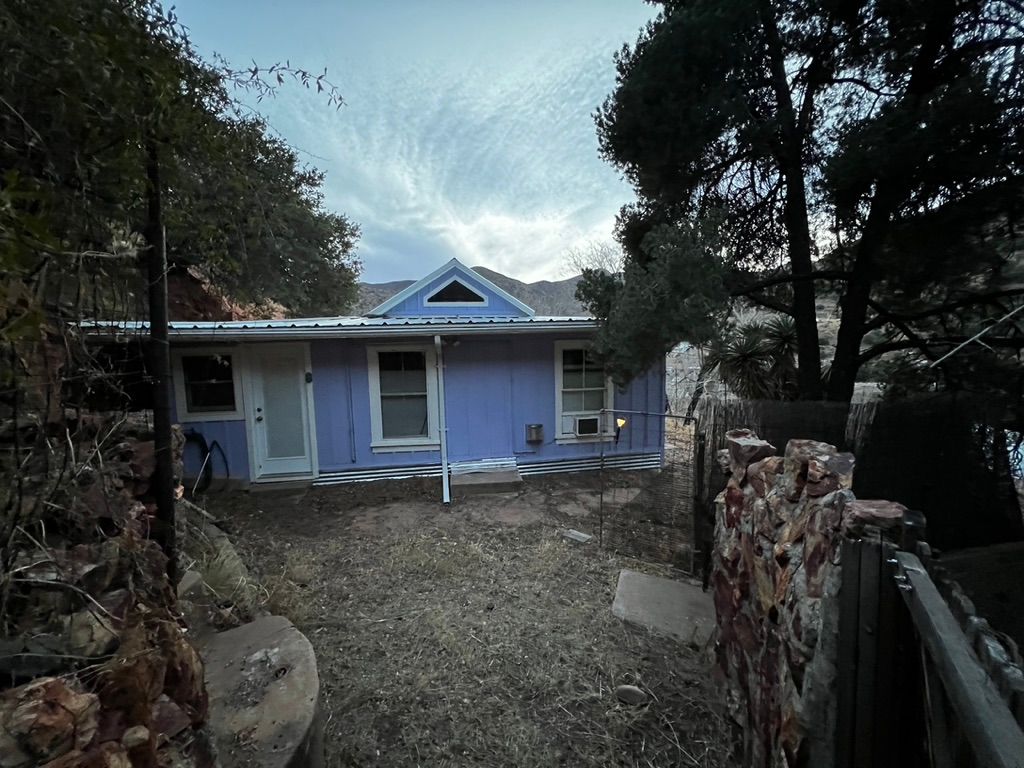
My impression after leaving Bisbee is that it is so densely-packed with strange history that every rock has a story of note if you take the time to turn it over.
Mike's tales center around the people who came after the mines. But the days when Phelps Dodge's operations were in full swing were probably more crazy. There were brothels and saloons all over the place while the town boomed. Fiona and I saw a documentary called Bisbee '17 four years ago in San Francisco which details the 100-year anniversary of when the mining corporation broke up a workers strike by forcibly loading them onto train cars and dumping them in the middle of the desert to die of starvation and thirst. Some of Fiona's relatives make acting appearances.
The town's mining past is still on-display everywhere. Big concrete concentrators sit idle, as do the giant metal headframes. But the biggest reminders are the vast pits.
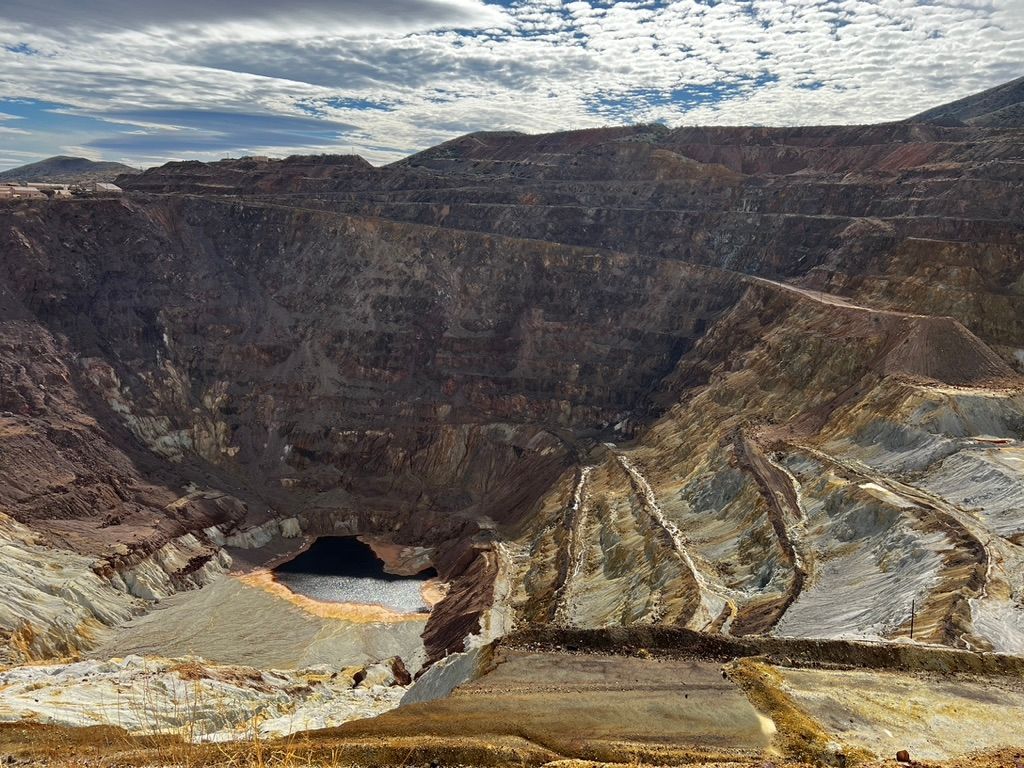
"The Lavender Pit," for example, ceased operation in the '70s and still sits dormant today, its access roads quietly eroding. The whole landscape is dotted with boarded-up mineshafts. There's occasional talk in town of Phelps-Dodge re-opening some operations. I doubt it, but the plan for all of this space is unclear.
If you walk east around the Lavender Pit, you get to the tiny town of Lowell, which is mostly deserted apart from a breakfast joint and a couple of shops.
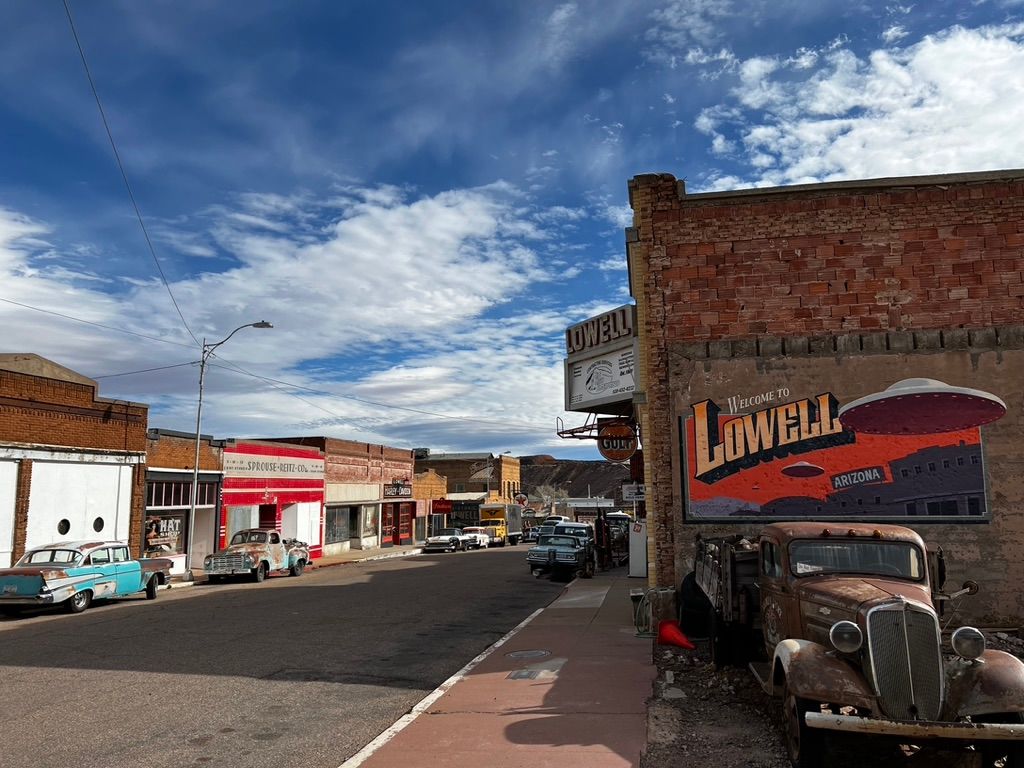
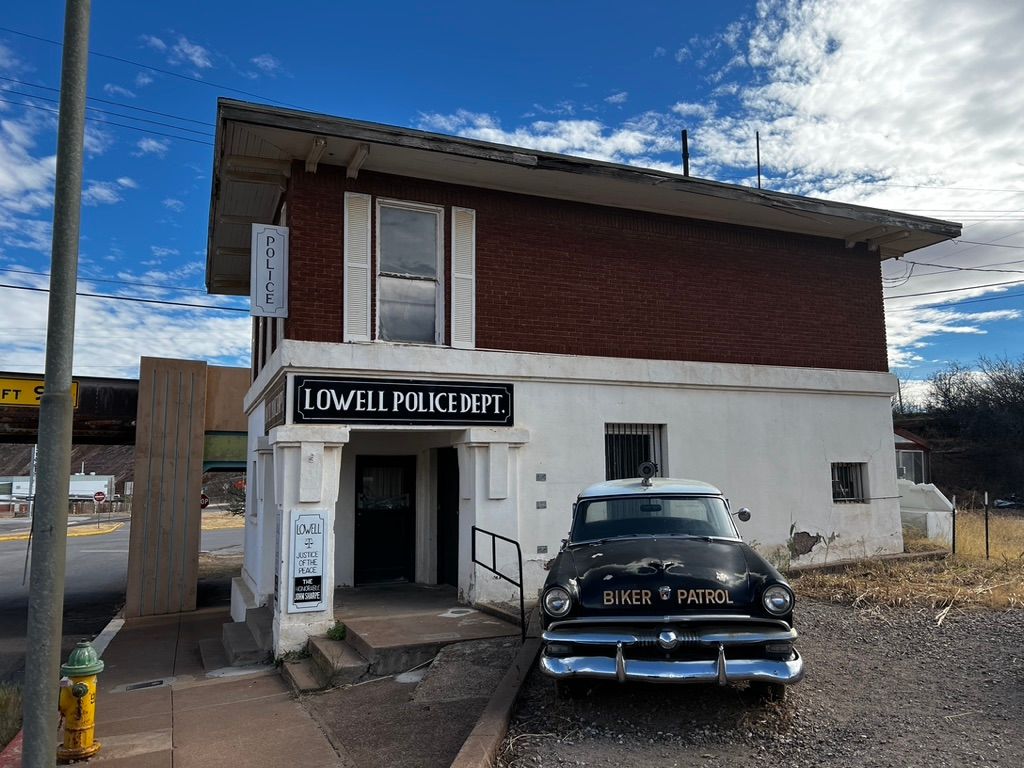
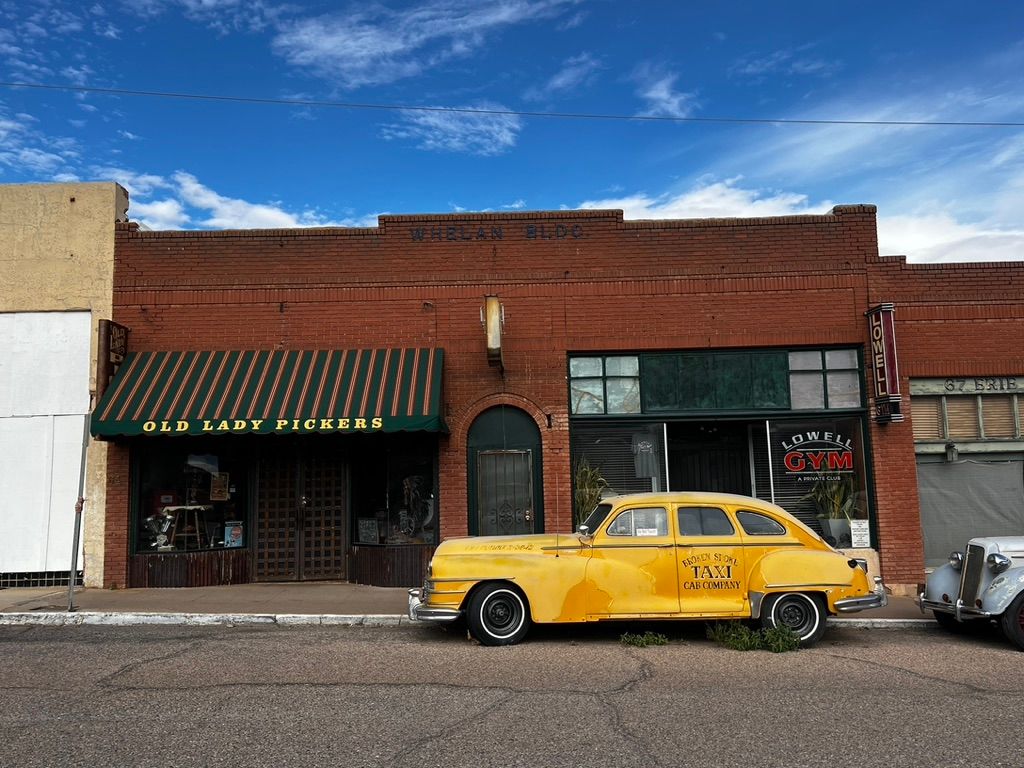
Bisbee is a quiet town with a layered and complicated past, full of booms, busts, characters and ghosts. It reminds me of innumerable layers of paint on a wall. Peel back one sheet and you find some odd and unexpected color beneath.
If you find yourself in Arizona near the border, it's worth stopping in for a pint at the Old Bisbee Brewing Company, swinging through the old town, and going for a hike in the copper-colored hills. Fiona's parents have been here for over thirty years and they're always uncovering something new in the red rock and crumbling miner's shanties.
Be sure to check out Mike Foster's work on Vimeo!
